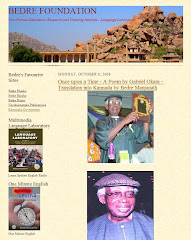ಸರ್ವಶಿಕ್ಷಾ ಅಭಿಯಾನ ಯೋಜನೆಯ ಮುಖ್ಯ ಉದ್ದೇಶಗಳಲ್ಲಿ ಪ್ರಮುಖವಾದ "ಯಾವುದೇ ಮಗು ಕಲಿಕೆಯಲ್ಲಿ ಹಿಂದುಳಿಯಬಾರದು, ಶಾಲೆಯಿಂದ ಹೊರಗುಳಿಯಬಾರದು" ಎಂಬ ಅಂಶಗಳಿಗೆ ಸಂವಾದಿಯಾದ ವ್ಯವಸ್ಥೆ ಈಗಾಗಲೇ ಅಮೆರಿಕಾದಲ್ಲಿ ಜಾರಿಯಲ್ಲಿದೆ. ಅದನ್ನು ಕುರಿತಂತೆ ದಿ ನ್ಯೂ ಇಂಡಿಯನ್ ಎಕ್ಸ್ ಪ್ರೆಸ್ ದೈನಿಕದ ಶಿಕ್ಷಣ ಪುರವಣಿಯಲ್ಲಿ ಬಂದ ಲೇಖನ ಇಲ್ಲಿದೆ ನೋಡಿ.

Article Published in The New Indian Express
Education Supplement on 17-11-2008
LESSONS FROM AMERICA'S LEARNING EXPERIENCE
Celebrated as the law that ushered in a new era, No Child Left Behind (NCLB) re-authorized the Elementary and Secondary Education Act, which is the princi- pal federal law affecting education from Kindergarten through high school In India, efforts should be made to tie up government aid with performanceS igned into law on January 8, 2002, The No Child Left Behind Act of 2001 (No Child Left Behind) is a landmark in education reform designed to improve and change the culture of US schools. Are there lessons to be learnt by India from America’s most discussed Educational Act?
Celebrated as the law that ushered in a new era, No Child Left Behind (NCLB) re-authorized the Elementary and Secondary Education Act (ESEA)- the principal federal law affecting education from Kindergarten through high school. In exchange for federal aid for education, states must establish systems of accountability that ensure that funds are used to improve the quality of education offered to every child in the State. NCLB- the rationale behind From 1965 through 2005, the US federal government had spent almost $ 300 billion to help educate children, particularly those who are disadvantaged. Despite this investment, the National Assessment of Educational Progress (NAEP) in reading showed that less than one-third of the fourth-graders could read at the proficient or advanced levels.
However, the assessment also showed that some schools in cities and towns achieved strong academic results, including those that have a history of low performance. If some schools could do it, then all schools should be able to do it. That was the rationale behind No Child Left Behind. The law is built on four commonsense pillars: accountability for results, an emphasis on doing what works based on scientific research, expanded parental options and increased local control and flexibility . Accountability for results As part of the accountability provisions, No Child Left Behind has set the goal of having every child achieving proficiency according to state-defined educational standards by the end of the 2013-14 school year. To reach that goal, every state has developed benchmarks to measure progress and make sure every child is learning. Data is analyzed separately for children of different racial and ethnic group, students with disabilities, students from economically disadvantaged home and children who are learning English as a second language. Those schools that do not meet the state’s definition of “adequate yearly progress” for two straight years are identified as ‘in need of improvement’ and they are given assistance to improve.
Provides help to schools in need of improvement NCLB insists that, when a school is found to be “in need of improvement,” school officials are required to work with parents, school staff, the district and outside experts to develop a plan to improve the academic achievement of all the students who attend the school.
The school’s improvement plan must incorporate strategies, relying on scientifically based research that will strengthen the teaching of core academic subjects especially in the subject areas that need improvement. Schools in need of improvement are also expected to develop strategies to promote effective parental involvement in the school and to incorporate a teacher-mentoring program. Scientifically based research No Child Left Behind puts a special emphasis on implementing educational programs and practices that have been clearly demonstrated to be effective through rigorous scientific research. Federal funding is targeted to support such programs, and schools are expected to use research and evidence of effectiveness to identify and select instructional resources, instructional practices and professional development strategies.
Gives parents new options Parents are given the option to transfer their child to another public school, including a charter school, in the same school district. Transportation must be provided to the new school, subject to certain cost limitations. If a school is identified for improvement for two or more years, it must provide public school choice and offer students from low-income families who remain in the school the option of obtaining free supplemental educational services (Tutoring). Other features of NCLB Improves teaching and learning by providing better information to teachers and principals.
Ensures that teacher quality is a high priority Gives more resources to schools.
.
Provides more information for parents about their child’s progress. Alerts parents on important information on the performance of their child’s school. No child left behind and the new administration NCLB has drawn considerable criticism from teachers union and lobbyists. Critics charge that tests vary too widely to evaluate school performance nationwide, that teachers are teaching narrowly to the test, that students who learn in different ways are put at a disadvantage, and that one test shouldn’t determine who passes and who doesn’t especially if there are errors in the test. There also remains the universal refrain from teachers union that resists any move threatening to increase workload. No Child Left Behind- Lessons for India Accountability has been missing in Indian Education System at large. From Research grants to financial aid of schools, very few procedures to ensure accountability have been enforced. Efforts should be made to tie up government aid with performance. India’s performance in rural education is a matter of serious concern. Our diminishing performance in research even from premier institutes like IIT’s should set alarm bells ringing. There is an urgent need for a performance linked funding law like No Child Left Behind. It is time our policy makers and educationists took stock of our dismal performance in the world education scenario. That our premier institutes in technology and science failed to make it in the top 50 in the world is a matter of serious concern. Let us answer the clarion call before it is too late.
S Alfred Devaprasad is CEO,
Celebrated as the law that ushered in a new era, No Child Left Behind (NCLB) re-authorized the Elementary and Secondary Education Act (ESEA)- the principal federal law affecting education from Kindergarten through high school. In exchange for federal aid for education, states must establish systems of accountability that ensure that funds are used to improve the quality of education offered to every child in the State. NCLB- the rationale behind From 1965 through 2005, the US federal government had spent almost $ 300 billion to help educate children, particularly those who are disadvantaged. Despite this investment, the National Assessment of Educational Progress (NAEP) in reading showed that less than one-third of the fourth-graders could read at the proficient or advanced levels.
However, the assessment also showed that some schools in cities and towns achieved strong academic results, including those that have a history of low performance. If some schools could do it, then all schools should be able to do it. That was the rationale behind No Child Left Behind. The law is built on four commonsense pillars: accountability for results, an emphasis on doing what works based on scientific research, expanded parental options and increased local control and flexibility . Accountability for results As part of the accountability provisions, No Child Left Behind has set the goal of having every child achieving proficiency according to state-defined educational standards by the end of the 2013-14 school year. To reach that goal, every state has developed benchmarks to measure progress and make sure every child is learning. Data is analyzed separately for children of different racial and ethnic group, students with disabilities, students from economically disadvantaged home and children who are learning English as a second language. Those schools that do not meet the state’s definition of “adequate yearly progress” for two straight years are identified as ‘in need of improvement’ and they are given assistance to improve.
Provides help to schools in need of improvement NCLB insists that, when a school is found to be “in need of improvement,” school officials are required to work with parents, school staff, the district and outside experts to develop a plan to improve the academic achievement of all the students who attend the school.
The school’s improvement plan must incorporate strategies, relying on scientifically based research that will strengthen the teaching of core academic subjects especially in the subject areas that need improvement. Schools in need of improvement are also expected to develop strategies to promote effective parental involvement in the school and to incorporate a teacher-mentoring program. Scientifically based research No Child Left Behind puts a special emphasis on implementing educational programs and practices that have been clearly demonstrated to be effective through rigorous scientific research. Federal funding is targeted to support such programs, and schools are expected to use research and evidence of effectiveness to identify and select instructional resources, instructional practices and professional development strategies.
Gives parents new options Parents are given the option to transfer their child to another public school, including a charter school, in the same school district. Transportation must be provided to the new school, subject to certain cost limitations. If a school is identified for improvement for two or more years, it must provide public school choice and offer students from low-income families who remain in the school the option of obtaining free supplemental educational services (Tutoring). Other features of NCLB Improves teaching and learning by providing better information to teachers and principals.
Ensures that teacher quality is a high priority Gives more resources to schools.
.
Provides more information for parents about their child’s progress. Alerts parents on important information on the performance of their child’s school. No child left behind and the new administration NCLB has drawn considerable criticism from teachers union and lobbyists. Critics charge that tests vary too widely to evaluate school performance nationwide, that teachers are teaching narrowly to the test, that students who learn in different ways are put at a disadvantage, and that one test shouldn’t determine who passes and who doesn’t especially if there are errors in the test. There also remains the universal refrain from teachers union that resists any move threatening to increase workload. No Child Left Behind- Lessons for India Accountability has been missing in Indian Education System at large. From Research grants to financial aid of schools, very few procedures to ensure accountability have been enforced. Efforts should be made to tie up government aid with performance. India’s performance in rural education is a matter of serious concern. Our diminishing performance in research even from premier institutes like IIT’s should set alarm bells ringing. There is an urgent need for a performance linked funding law like No Child Left Behind. It is time our policy makers and educationists took stock of our dismal performance in the world education scenario. That our premier institutes in technology and science failed to make it in the top 50 in the world is a matter of serious concern. Let us answer the clarion call before it is too late.
S Alfred Devaprasad is CEO,
Alpha Group of Educational Institutions. On invitation, he attended the Inter national Visitors Leadership Program on ‘Education Today’, held in the US from October 14-31. He can be reached at














No comments:
Post a Comment